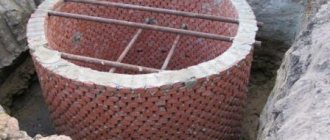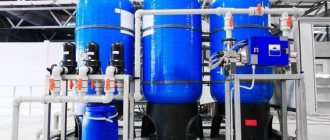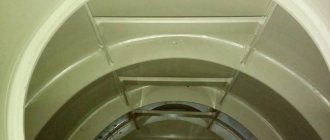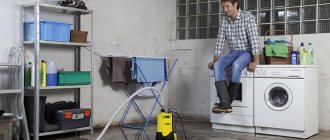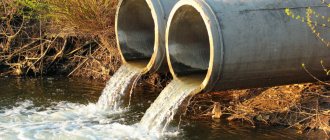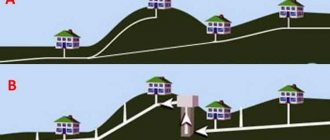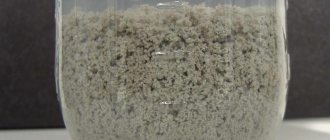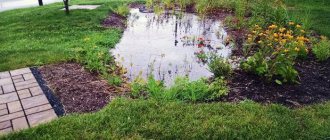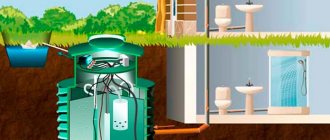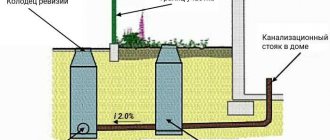Typically, wastewater is divided into three types:
- Production
- Atmospheric
- Household
All of them somehow end up in the sewer, but first they must go through special wells with hydraulic seals.
Wastewater classification
Wastewater Wastewater
, depending on its origin, is divided into several types:
- Household, coming from plumbing fixtures installed in residential, public and industrial buildings. They are contaminated in most cases with physiological secretions and household waste.
- Industrial, which are the product of various technological production processes related to the use of water.
- Atmospheric (rain), resulting from precipitation (rain, showers, melting snow and ice).
Wastewater is classified according to sanitary standards, subject to strict compliance. All types of wastewater contain some amount of organic and mineral contaminants.
The composition of contaminants can be different:
- Domestic water is usually the most polluted because it contains a lot of organic compounds that can rot
. They contain feces, urine and various bacteria, including many pathogens belonging to the pathogenic group. - Industrial waters are divided into contaminated and conditionally clean.
The latter include those that are used for cooling various industrial units . The composition of substances polluting industrial waters can be very different, depending on the technology of production processes. - Wastewater generated by prolonged rains and downpours enters the collector slightly polluted
. That is why, in order to reduce the diameter of the pipes of the city sewer network and reduce the volume of wastewater treatment plants, several chambers are provided on the central collector. They are equipped with storm drains and storm drains, due to which storm water is mixed with other wastewater and, without being purified, is released into water bodies.
When using a common sewer system, all wastewater enters the treatment plant, where it is first thoroughly purified and then discharged into water bodies.
Purification of various wastes
Industrial
Industrial and industrial wastewater needs to be treated to reduce the load on city facilities . The technological scheme differs fundamentally depending on the composition of the wastewater. Some wastewater is saturated with organic matter, others with heavy metal ions.
Indicators of TSP (total suspended particles), BOD5 and COD can reach tens of hundreds of mg/l. The acidity level often exceeds 6-9.
Before discharging wastewater into the city treatment system, BOD5 is adjusted to 400 mg/l, and the pH is reduced to 6-9. The technological scheme is selected depending on the composition of the water.
The above methods are combined in different sequences , some may be eliminated.
Household
This category of wastewater includes water from the bathroom, kitchen, laundry and water that is formed after cleaning the premises. About 58% of pollution is organic, and 42% is mineral. Domestic wastewater contains detergents and pathogens.
Common methods for treating household wastewater are biological. Disinfectants and disinfection reagents must be used .
Superficial
These wastes include:
- rain;
- thawed;
- Irrigation water from populated areas and industrial sites.
Through the drainage system, the liquid enters the sewer, then enters the sump.
Some of the impurities settle out, after which the wastewater is pumped to a flotator, where oil products are removed.
Then purification occurs using mechanical and sorption filters. The wastewater is disinfected and returned to natural bodies of water .
Separate sewer system
Separate sewerage
Sewerage organized according to a separate system is of three types:
- Full separate;
- Separate;
- Incomplete separate.
A complete separate sewerage system consists of two independent networks of pipelines and channels. Through one of them, called domestic, domestic and industrial waters are discharged, and through the other, called drainage, rain and relatively clean industrial waters are discharged.
Helpful information ! The wastewater passing through the household network then ends up at treatment facilities located outside populated areas. And rainwater is discharged into reservoirs through the drainage network in the shortest possible way.
The diameters of pipes and channels of the household network belonging to a complete separate system are significantly smaller than those used for storm sewer installations. This is due to the fact that the calculated volume of rainwater, as a rule, exceeds the same indicator for domestic water by 20–50 times, and sometimes much more.
Separate sewer system with only one network? household, is called an incomplete separate system.
Cleaning methods
Domestic wastewater may contain soluble or insoluble impurities. Depending on the size of the particles contained, they can be divided into:
- emulsions and suspensions – 0.1 microns;
- colloids – from 0.1 microns to 1 nm;
- dissolved particles.
Cleaning is done using different methods and means. Cleaning methods are divided into several groups:
- mechanical – filtration and hydrodynamic processes;
- physico-chemical – chemical and thermal treatment;
- biological - processing by bacteria.
When choosing a cleaning method and process, it is necessary to take into account the degree of contamination, content and size of impurities. Most often, for household (domestic) wastewater, biological and mechanical methods are used.
Video: Methods and facilities for wastewater treatment
Biological wastewater treatment
In nature, water is purified by microorganisms that live in it or the soil. Bacteria break down organic particles into gas and water. This method, although effective, is quite long.
Bacteria need an ideal environment for their life. For example, for aerobic microorganisms that require oxygen to function, aeration systems have to be installed.
But their brothers - anaerobic bacteria, do not need oxygen and cope well with their duties in sealed containers. It’s just that as a result of their work, gas is released, so for buildings in which these microorganisms are used, it is necessary to install a ventilation system.
On a note! Biological wastewater treatment is used only after mechanical treatment.
Mechanical methods
Any wastewater treatment begins with sedimentation or filtration, due to which large impurities are removed from the liquid. For this, coarse filters are used, such as sieves, gratings, sand traps, etc. Most treatment plants use a settling method in which heavier particles settle to the bottom, and lighter particles move to the next stage.
On a note! During mechanical treatment, up to 65 - 70% of impurities are removed from household wastewater.
Chemical cleaning
This method is based on adding chemicals to wastewater. As a result of the reaction that occurs during the interaction of chemicals with impurities contained in wastewater, a sediment is formed, which in turn is removed mechanically.
This method allows you to remove up to 25% of soluble and 95% of insoluble impurities. To disinfect water, potassium permanganate, chlorine and other substances capable of disinfection are used.
Physico-chemical method
For the purification and disinfection of domestic sewage, the physico-chemical method is rarely used. It is mainly used in wastewater treatment plants intended for the treatment of industrial wastewater.
Physico-chemical methods include:
- coagulation;
- flocculation;
- flotation;
- adsorption;
- ion exchange method;
- reverse osmosis method.
Since this technique is practically not used in domestic sewage, we will not analyze each point in detail in this article.
Semi-separate sewer system
Semi-separate sewerage also consists of two independent networks. But the composition of the waste in it is slightly different than in a separate one. One network is designed for the disposal of domestic and industrial wastewater (contaminated) and in addition? the first streams of dirty rainwater. The second network drains rainwater (relatively clean) and industrial (relatively clean) wastewater.
To separate rainwater, special chambers (interceptors) are used.
As for the combined sewer system, it can be installed in certain areas of cities that have a variety of sewer systems.
Helpful information ! The semi-separate sewage system is the most advanced from the point of view of sanitary standards. Since it is precisely this system that ensures the removal of all types of contaminated water from urban areas to treatment facilities located outside populated areas.
But since the arrangement of two networks at once with interceptor cameras, which are also far from perfect, is a rather labor-intensive and expensive undertaking, semi-separate sewage systems are not currently used.
Possible problems
They want to equate the standards for the content of pollutants in treated wastewater to the world standards, and the majority of Russian enterprises use physically outdated equipment .
Purification using technologies developed in the last century does not reduce the level of impurities to the required levels.
Modern equipment is expensive. For example, UV disinfectants are installed only in the capital and several large cities. In most populated areas, the equipment has become so outdated that wastewater is often discharged into water bodies without treatment.
Some private entrepreneurs do not want to invest in the construction of treatment facilities. They dump polluted water into rivers.
Other wastewater treatment problems:
- Selection of an ineffective technological scheme;
- Inability to dispose or bury waste, pollution, and by-products;
- Lack of money for electricity, equipment maintenance and repair, and transportation costs.
Existing problems can only be solved at the legislative level : increase fines for violations, finance city wastewater treatment plants and control the expenditure of money, encourage private owners to introduce new technologies, offering them various discounts and benefits.
Honest inspections should be carried out more often, which can be spontaneous - without warning.
Internal sewerage, depending on the composition of wastewater, is divided into
- Household (household) designed for the removal of domestic wastewater from buildings. Sometimes production water is also discharged into it, if its quality and quantity allow such a discharge;
- Industrial, which is used to drain wastewater from production workshops and premises;
- Rainwater (internal drains), ensuring the removal of rain and melt water from the flat roofs of residential, public and industrial buildings.
Internal domestic sewerage consists of wastewater receivers (plumbing fixtures), sewerage distribution to the risers, the risers themselves, equipped with inspection, pipelines to which the risers are connected, and outlets. In turn, each riser ends in a ventilation pipe equipped with a deflector.
Rules for receiving wastewater
Reception of wastewater into the general city sewer system is determined by sanitary norms and rules.
Based on this, all wastewater receivers must have hydraulic seals that prevent the penetration of contaminated air from the sewer into the premises.
Advice! To clean the sewer system, it is necessary to install inspections. And since the process of decomposition of organic compounds in wastewater occurs, the street sewer network must be ventilated using internal sewer risers.
Disposal and treatment of wastewater discharged through the internal industrial sewerage network directly depend on production technological processes, features of the equipment used, as well as the degree of pollution and volume of wastewater that is generated.
Stages of contaminant extraction
There are 3 degrees of extraction of contaminants from wastewater:
- Primary – removal of debris, coarse impurities, surface contaminants and suspended solids.
- Secondary – decomposition of organic waste.
- Tertiary (additional treatment) – extraction of suspended and colloidal particles, pesticides, fungicides, precipitation of phosphorus and nitrogen residues, reduction of COD. Indicators are brought to the standards of ODU or MPC.
At these stages, the following methods are used:
- Mechanical - the use of stationary or mobile filter units: coarse filters, sedimentation tanks, surface contaminant traps. After mechanical cleaning, the amount of contaminants in wastewater is reduced by 30-60%.
- Biological – cleaning using living microorganisms: bacteria, fungi, protozoa. Microorganisms use organic matter as food and convert it into safe biogas, methane and water. Biological methods eliminate 92-96% of contaminants.
- Physico-chemical – purification of wastewater from dissolved impurities and suspended solids using the laws of physics and chemical reagents. 96-98% of fine particles are removed from water.
- Disinfection – destruction of pathogenic bacteria and viruses. According to regulations, wastewater must not contain pathogens, so the efficiency of disinfection reaches 99.9%.
To clean gasoline, fuel oil, kerosene, and petroleum oils, oil traps and porous sorbents are most actively used:
- Activated carbon;
- Clays;
- Coke;
- Peat;
- Ash;
- Silica gels.
Reference. The maximum permissible concentration of petroleum products in wastewater does not exceed 0.01-0.3 mg/l. Such small values are due to the toxicity of the compounds to living organisms.
What are internal and external sewer networks made of?
Modern sewage system
The internal drainage system consists of drainage funnels into which water flows from the roof, drainage pipes connecting the funnels and risers, risers and internal receiving trays into which water flows from the risers. In order to ensure maintenance and reliable operation of the network, in addition to these elements, audits and wells are installed.
Helpful information ! Yard sewer networks include street and intra-block ones. They are designed to collect wastewater passing through internal sewer systems and their further disposal.
The organization of sewer systems without the installation of treatment facilities is allowed only in exceptional cases, and then in the presence of a special permit for the discharge of wastewater, which is issued by the State Sanitary Inspectorate.
Wastewater treatment using flocculation method
Flocculation is a process in which small particles that are suspended in water, when special substances (flocculants) are added to it, begin to form rapidly settling large compounds in the form of flakes. They are subsequently removed from the total amount of wastewater using methods such as filtration, sedimentation or flotation.
Back in the 30s, technologies for water purification using flocculation were developed. And today it is widely used for the purification of domestic and industrial waters.
The mechanism of action of flocculants is the absorption of their molecules over the entire surface of colloidal particles, with the further formation of a network in the structure of the flocculant molecules and the adhesion of all colloidal particles under the influence of van der Waals forces.
Flocculants, which are used for wastewater treatment, create three-dimensional structures between colloidal particles, and these structures, in turn, are capable of complete and fairly rapid separation of the liquid component.
Such structures arise due to the adsorption of flocculant molecules on certain particles, which leads to the formation of compounds between them in the form of polymer bridges.
Chemical pollution
Output of surface wastewater with impurities
The quantitative and qualitative composition of all contaminants is varied. But all chemical pollution can be divided into two groups:
- The first category includes pollution containing inorganic impurities. These include wastewater from sulphate and soda plants and processing plants. In their composition, they contain large quantities of heavy metal ions, alkalis and acids. They change the quality composition of water.
- The second group includes wastewater from oil refineries, petrochemical plants, organic synthesis enterprises, and coke production plants. Wastewater contains large quantities of phenols, aldehydes, resins, ammonia, and petroleum products. Their harmful effect is that the organoleptic characteristics of water deteriorate, the oxygen content in it decreases, and the biochemical need for it increases.
Currently, the main pollutant of water bodies is oil and petroleum products. When they enter water, they create a film on its surface, and heavy fractions settle to the bottom. Taste, color, viscosity, surface tension changes. Water acquires toxic properties and poses a threat to humans and animals.
Wastewater from petrochemical plants contains phenol. When it gets into water bodies, the biological processes occurring in them sharply decrease, and the process of self-purification of water is disrupted. There is a carbolic acid smell in the water.
Pulp and paper industry enterprises have a detrimental effect on the life of water bodies. The wood mass oxidizes, a significant consumption of oxygen occurs and, as a result, fry and adult fish die. Insoluble substances and fibers worsen the physical and chemical properties of water. Mole alloys have a harmful effect on water bodies. Tannins are released from bark and rotting wood into the water. The resin absorbs oxygen, which leads to the death of fish. In addition, moth alloys clog rivers and clog their bottoms. At the same time, fish are deprived of spawning grounds and feeding grounds.
Treatment stations
Treatment station
For the treatment of storm water there are special stations, the abbreviated name of which is? LIOS.
They are used to remove suspended particles and petroleum products from storm water to the level of certain requirements for their condition at the time of discharge into water bodies or onto the terrain.
Based on the requirements of customer enterprises, special treatment facilities are developed where the process of post-treatment of wastewater is carried out.
Sewage treatment plants clean stormwater using various methods:
- Mechanical;
- Physico-chemical;
- Sorptive.
Using these methods, wastewater is effectively purified and disinfected from various harmful substances and petroleum products. LIOS have been developed for deeper and more thorough wastewater treatment.
They make it possible to purify storm drains to the standard level of discharge into various reservoirs, where the process of their disposal takes place.
Industrial and storm water treatment is carried out on the basis of specially developed schemes, depending on the technology, which include different methods of water treatment, taking into account the type and degree of pollution.
The operating principle of the general scheme for treating all storm water is to ensure its minimum discharge, which does not exceed permissible pollution standards, into the reservoir.
The use of LIOS makes it possible to use completely purified storm water in industrial production processes, running them through a cycle, due to which the costs of enterprises for water supply and wastewater disposal are significantly reduced.
Treatment plants
A sewage treatment system is a set of equipment that separates or neutralizes foreign components. These are mechanical, chemical and organic impurities that are removed in different ways. As a rule, large treatment plants use complex methods for separating impurities. The wastewater sequentially goes through different stages of mechanical and chemical neutralization. The most complex types include the treatment of domestic sewage. The equipment includes:
- settling tanks. These are containers in which wastewater is kept to allow heavy particles to settle to the bottom;
- Sand traps. Devices that separate small solid particles - sand, glass, small debris;
- grates. They catch large objects - branches, plastic bags, rags, etc.
After sifting out the mechanical components, the wastewater enters the chemical treatment sections. In them, the liquid is mixed with reagents that neutralize household chemicals, detergents and other pollutants. In addition, coagulants are introduced that bind certain compounds. As a result, they settle to the bottom or float up in the form of foam.
The sewage system of private houses is usually built on the basis of septic tanks. These are tanks divided into several sections. Liquids settle in them. Clarified water passes from one section to another through overflow holes. The last element of the circuit is the filtering node. It ensures the absorption of water into the soil for soil purification.
Operating principle of the aeration tank
Let's look at how sewage is purified using biologically active components. This is an effective technique that can clean up to 98% of wastewater. A positive result is achieved only with a well-organized process and strict adherence to technology.
The operating principle of the aeration tank is to treat wastewater with biologically active sludge. The design is a rectangular tank connected to a sewerage supply pipeline. The wastewater enters the tank and is mixed with activated sludge. They are then pumped into a second tank to undergo purification. The active element of sludge is aerobic bacteria that absorb organic matter. For normal life, they need oxygen, so the drains in the tank are continuously saturated with fresh air.
Purified water is removed from the second tank to the discharge point, and a new volume of wastewater is supplied to replace it from the first tank. Excess activated sludge is removed through a separate pipeline. The composition of aerobic bacteria is periodically replenished.
The operation of aeration tanks shows high efficiency only if the calculations are correctly performed and technological requirements are observed. High-quality water purification from organic impurities is carried out, as well as fluorine and nitrogen are removed. However, it is necessary to carefully control the initial composition of the wastewater. If they contain compounds that are harmful to aerobic bacteria, this technology cannot be used.
Disinfection of clarified water
In addition to purification from impurities, water must be disinfected. This is the last stage of treatment before the purified water discharge procedure. The purpose of disinfection is to destroy pathogenic microorganisms.
Water treatment is carried out in separate tanks. Chlorine compounds (for example, bleach) are used as a reagent. At the outlet, the composition of the water is tested for compliance with sanitary standards. This is an important stage on which the prevention of the spread of infections and the prevention of epidemics depends.
In addition to treatment with chlorine-containing compounds, ultraviolet irradiation of water is used. This technique gives a very high effect, gradually replacing traditional methods of disinfection.
Ammonia nitrogen pollution
Among other contaminants, wastewater contains ammonia nitrogen, which is contained there in the form of free ammonia and various salts.
On the one hand, wastewater purified from ammonia nitrogen can be further used in the coke industry.
On the other hand, if wastewater that has not been purified from ammonia nitrogen is discharged into water bodies, this leads to waterlogging. That's why cleaning it is a must.
Types of cleaning
- Until recently, the following method of wastewater treatment was widespread: sewage was kept in special storage tanks, which were then emptied using sewage disposal equipment.
- The chemical method was also quite popular, in which chemicals were used to accelerate the decomposition process.
- Today, traditional treatment facilities can no longer cope with the loads and large volumes of wastewater, which has contributed to the search for more effective and safe treatment methods.
This method was the biotreatment of wastewater, which not only turned out to be very effective, but also established itself as the safest and most environmentally friendly.
What is it and why is it needed?
Wastewater treatment is an activity by which pollutants are removed from industrial and domestic wastewater. The complex is carried out before the liquid is discharged into reservoirs .
Each enterprise is obliged to carry out wastewater treatment; this is stipulated in the Water Code of the Russian Federation and the Federal Law of 2011 “On Water Supply and Wastewater Disposal”.
If measures are neglected, pollution will enter the natural reservoir and soil, and poison the local ecosystem. The number of plants and animals will decrease. Hazardous substances accumulate in biota and enter the human body through the food chain.
Industrial and domestic wastewater
can be sent to the same treatment plant .
Mixing them optimizes the ratio of carbon and sodium, carbon and phosphorus, which increases the efficiency of biological treatment.
The process takes place at industrial or municipal wastewater treatment plants.
Reference. If residential buildings are not connected to the central sewer system, domestic local facilities (LOFs) are used to treat wastewater.
Industrial VOCs are required if the effluent contains aggressive or biotoxic contaminants. The bulk of impurities are removed, then the water is supplied to general production facilities.
Bioremediation
Sewer well
Bioremediation is based on the use of special bacteria that accelerate the decomposition processes of organic compounds. Under their influence, various compounds constantly contained in wastewater break down into harmless elements.
Modern manufacturers produce biological treatment systems that use both aerobic and anaerobic bacteria.
For active life of aerobic bacteria, an environment enriched with oxygen is required, but anaerobic bacteria do not need it, since they live and reproduce well in conditions associated with the complete absence of air.
The wastewater biotreatment process consists of several stages:
- First, wastewater is collected in special containers (vacuum separators), where it settles and undergoes fermentation.
- As a result, the resulting clarified water is diluted with soil water at the next stage of processing, called filtration.
- The final stage is as follows: the prepared water moves into an environment saturated with oxygen, where bacteria are located, which immediately begin to work. With their help, final cleaning occurs, after which clean water can be drained into the ground.
Protection of water bodies from wastewater pollution
Wastewater from industrial enterprises and populated areas is the main source of pollution of water bodies.
Thus, untreated surface wastewater with a high content of microorganisms and organic substances, when released into natural bodies of water, such as rivers and lakes, leads to disruption of their natural regime.
In this case, the following negative processes occur:
- absorption of oxygen dissolved in water;
- reduction in water quality in reservoirs;
- settling of various sediments to the bottom of reservoirs;
- water becomes unsuitable for drinking, and often even for technical use;
- fish die out in water bodies, etc.
Pollution of natural and artificial reservoirs with wastewater also leads to a deterioration in their appearance and significantly reduces their suitability for swimming, tourism, water sports, etc., therefore biotreatment of wastewater is a mandatory procedure.
The degree of purification and conditions for the release of wastewater into water bodies are regulated by special “Rules for the protection of surface waters from pollution by wastewater.”
These Rules establish two types of standards that must be met by the quality of water in a reservoir in accordance with the nature of its use (reservoirs for drinking or cultural and domestic use, as well as reservoirs used for fishing purposes), as well as maximum permissible concentrations of various substances in water, which are used as initial data in the process of determining the conditions for discharging wastewater into water bodies.
Current legislation also prohibits the release of untreated wastewater into water bodies, and also regulates the supervision of the quality of wastewater discharged into water bodies and such additional measures as wastewater treatment.
